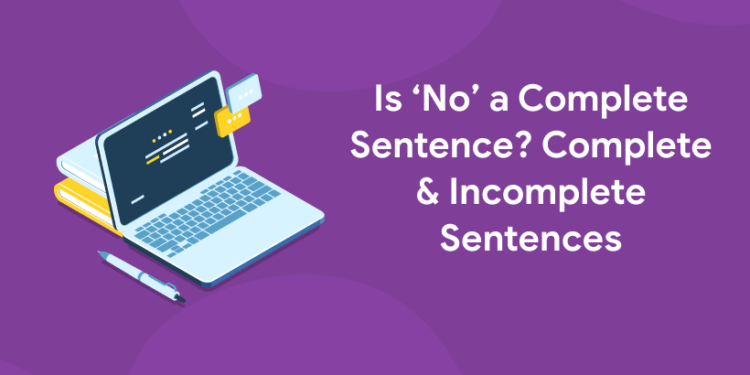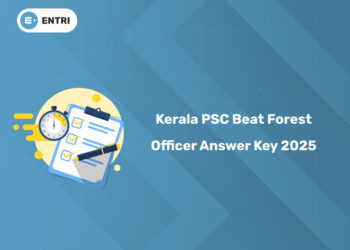Table of Contents
Key Takeaways:
- A complete sentence needs a subject, a verb, and a complete idea to stand on its own.
- The word “No” is a sentence fragment that conveys meaning through context but isn’t formally a sentence.
- In conversational English, fragments like “No” are common, but formal writing requires full sentences for clarity.
- Recognizing sentence fragments helps avoid confusion and improves professionalism in writing.
- Practice forming complete sentences to boost your communication skills for both speech and writing.
Introduction
Few things in communication are as common yet confusing as the single word “No.” Ever found yourself responding to a question with just this word and wondered—is it even a complete sentence? Whether you’re writing an email, giving a presentation, or chatting casually, knowing how to form correct sentences ensures your thoughts come across clearly. This blog breaks down the mystery behind whether “No” counts as a full sentence, explores the idea of complete and incomplete sentences, and offers practical tips to sharpen your language skills.
Language is fluid, and informal conversation often bends rules—but when clarity and professionalism matter, understanding the nuts and bolts of grammar makes all the difference. If you want to avoid awkward misunderstandings and communicate with confidence, this guide is for you.
What Is a Sentence? The Basics
1: Which of the sentences below is grammatically correct?
Fundamentally, a sentence is a string of words that conveys a complete idea. Grammatically, a sentence should:
- Begin with a capital letter
- Contain a subject (who or what the sentence is about)
- Include a predicate or verb (what the subject does or is)
- Express a full thought
- End with appropriate punctuation (period, question mark, or exclamation point)
Here’s what this looks like in practice:
| Sentence Element | Explanation | Example |
|---|---|---|
| Subject | The main actor or focus | She |
| Predicate/Verb | What the subject is/does | runs fast |
| Complete Thought | Full meaning conveyed | She runs fast every day. |
Tip: Always check if your sentence answers the questions: Who? What happened? When? Where? Why?
Spoken English Course for Guaranteed Confidence and Career Growth
Spoken English Course by Entri App: Enhance your communication skills, gain certification, and boost your career with confidence.
Join Now!Types of Sentences to Know
Understanding the different types of sentences is essential for mastering English grammar and improving both writing and speaking skills. Sentences can be classified from two perspectives: structural classification, which looks at the arrangement of clauses, and functional classification, which considers the sentence’s purpose or intent.
1. Sentences Based on Structure
These focus on how clauses (groups of words including a subject and verb) are arranged within the sentence. Here’s a detailed look with examples:
| Sentence Type | Definition | Example |
|---|---|---|
| Simple Sentence | Contains one independent clause (a subject + predicate) only. | “She writes every day.” |
| Compound Sentence | Contains two or more independent clauses joined by coordinating conjunctions (and, but, or, so, etc.) or semicolons; no dependent clauses. | “I wanted to stay, but I had work to do.” |
| Complex Sentence | Has one independent clause and at least one dependent (subordinate) clause, introduced by subordinating conjunctions like because, although, if. | “She stayed home because it was raining.” |
| Compound-Complex Sentence | Includes two or more independent clauses and at least one dependent clause. | “Although he was tired, he finished his homework, and then he went to bed.” |
Understanding Clauses
- Independent Clause: Can stand alone as a complete sentence because it expresses a full thought.
- Dependent Clause: Cannot stand alone and needs an independent clause to complete the meaning.
2. Sentences Based on Function
This classification depends on the talking purpose — why the sentence is said or written. There are four main types:
| Sentence Type | Purpose | Example | Ending Punctuation |
|---|---|---|---|
| Declarative | To state facts, opinions, or information | “I enjoy reading books.” | . (period) |
| Interrogative | To ask questions | “What time does the train arrive?” | ? (question mark) |
| Imperative | To give commands, requests, or advice | “Please close the window.” | . or ! |
| Exclamatory | To express strong emotions or surprise | “What a beautiful view!” | ! (exclamation mark) |
Quick Tips to Identify Sentence Types:
- Does the sentence state something? It’s probably declarative.
- Is it a question? Then it’s interrogative.
- Does it command or request? It’s imperative.
- Does it show emotion or excitement? It’s exclamatory.
Understanding these sentence types helps you choose the right style and tone when communicating, whether it’s writing an email, asking questions, or giving instructions.
How to Spot a Complete Sentence
To identify complete sentences, here are the key characteristics:
| Feature | Description | Example |
|---|---|---|
| Capital Letter | Sentence starts with capital | He walks home. |
| Subject and Verb | Both are essential for a full thought | Birds (subject) fly (verb). |
| Punctuation | Ends with period, question mark or exclamation | She walks home. |
| Complete Idea | Does it answer a question or express thought? | She walks home fast after school. |
Tip: If you feel something’s “missing” or your sentence makes the reader ask “then what?”, you likely have a fragment.
Incomplete Sentences or Fragments
Fragments are common but problematic in writing as they interrupt flow and clarity.
| Fragment Example | Why It’s Incomplete | Revision for Completeness |
|---|---|---|
| Because it rained today. | Starts with a subordinating conjunction, no main clause | I stayed inside because it rained today. |
| Running late to work. | Missing subject | I was running late to work today. |
| After the game. | Dependent clause without independent clause | After the game, we went out for dinner. |
Tip: To fix fragments, add missing parts such as the subject, verb, or independent clause.
Spoken English Course for Guaranteed Confidence and Career Growth
Spoken English Course by Entri App: Enhance your communication skills, gain certification, and boost your career with confidence.
Join Now!The Truth About “No” as a Sentence
The word “No” sparks a common debate among language learners, writers, and even native speakers: Is “No” a complete sentence or just a fragment? The answer lies in understanding grammar rules, sentence structure, and the contexts in which “No” is used.
Why People Say “No” Is a Complete Sentence
In everyday conversation, “No” is often used as a standalone response that clearly communicates refusal, disagreement, or denial. It’s short, direct, and immediately understood. Psychologically and socially, saying “No” firmly without elaboration is important for setting boundaries and making decisions confidently. In fact, some language advocates use the phrase “No is a complete sentence” to empower people to say no without feeling pressured to justify themselves.
In this informal sense, “No” carries the full weight of a sentence because the context supplies the missing parts. For example:
- Question: “Do you want some coffee?” Response: “No.” (The full idea is implied: “No, I do not want any coffee.”)
| Free PDFs for download | |
The Grammar Perspective: What Makes a Sentence?
From a strict grammatical standpoint, a sentence must contain:
- A subject: the person, place, or thing the sentence talks about.
- A finite verb: the action or state of being tied to the subject.
- A complete thought: the sentence should stand alone and make sense.
“No” alone does not satisfy these requirements because:
- It has no explicit subject — who is saying “no”?
- It has no verb — what action or state is being expressed?
- Without additional context or words, it fails to present a complete thought.
Thus, grammatically, “No” is classified as a sentence fragment.
| Aspect | Explanation | Example |
|---|---|---|
| Subject | Missing in “No” | Implicit “I” |
| Verb | Missing in “No” | None |
| Complete Thought | Dependent on context, not self-standing | Implied “I do not want that.” |
Elliptical Sentences vs. Fragments
Some argue “No” is part of an elliptical sentence—a sentence where some words are omitted because they are understood from context. Elliptical sentences still form complete ideas by relying on implied information from the previous sentence.
For example:
- “Are you coming?”
- “No, I am not coming.”
Here, “No” is a shortened form of “No, I am not coming,” which is a complete sentence. The ellipsis omits the repeated part in the response.
However, on its own, “No” remains a fragment because the initial question or statement provides the necessary context. Without it, “No” by itself cannot express a full idea, which is the core criterion for a complete sentence.
When Is It Appropriate to Use “No” as a Sentence?
- In spoken language, to respond quickly and clearly to questions or offers.
- In informal writing, like text messages, chats, or notes where brevity is valued.
- When the context is clear and understood by both speaker and listener.
When Not to Use “No” Alone
- In formal writing (essays, reports, professional emails), always aim to use full sentences for clarity and professionalism.
- In contexts where the meaning might be ambiguous and additional information or politeness is needed.
Expressing Negation with “No”
Apart from being a standalone response, “No” functions grammatically as:
- A determiner placed before nouns to indicate the absence of something: Example: “There are no cookies left.”
- Part of phrases like no parking, no smoking, which serve as clear instructions or prohibitions.
It’s important not to confuse “No” with “Not,” which negates verbs, adjectives, or adverbs, and requires different grammatical use.
| Use Case | Description | Example | Complete Sentence? |
|---|---|---|---|
| Standalone response in speech | Quick negation or refusal | “No.” | No (fragment, implied) |
| Elliptical sentence component | Shortened full sentence in dialogue | “No, I am not coming.” | Yes |
| Determiner before nouns | Indicates zero quantity or absence | “There are no apples.” | Yes |
| Formal writing | Use complete statements | “No, I do not agree.” | Yes |
Tip for Learners
Use “No” confidently in conversations when you need to give a brief negative reply. But when writing formally or explaining something fully, add the subject and verb to form a complete sentence, such as, “No, I do not agree,” or “No, thank you.”
Understanding these nuances empowers you to use “No” appropriately across different communication settings, helping you sound more natural and grammatically correct when it counts most.
Improve with Entri’s Language Courses
Ready to transform your English skills? Entri’s Spoken English Course focuses on real-world communication, teaching you how to construct sentences confidently, enhance your vocabulary, and sound natural in conversations.
Additionally, the Career Level-up Course builds essential communication, personality development, and soft skills to help you succeed professionally.
Conclusion: Take the Next Step in Communication
Understanding the essentials of sentence structure, like why “No” isn’t a complete sentence, is just the start. Clear communication opens doors in your career and personal life. Enrolling in Entri’s expertly designed courses is a smart move to sharpen your English, boost confidence, and stand out in any setting. Why wait? Start your journey towards polished speaking and writing today.
Spoken English Course for Guaranteed Confidence and Career Growth
Spoken English Course by Entri App: Enhance your communication skills, gain certification, and boost your career with confidence.
Join Now!Frequently Asked Questions
Can "No" be a complete sentence?
No, grammatically it lacks a subject and verb, so it’s a sentence fragment.
Why do people use "No" as a sentence?
It’s a quick, context-based reply common in spoken English but not grammatically complete.
How can I tell if my sentence is complete?
Check for a subject, verb, and whether the idea feels whole and clear.
What is an elliptical sentence?
A sentence where some words are omitted but implied; different from fragments like “No”.
How do I fix fragments?
Add the missing subject, verb, or clause to complete the thought.













